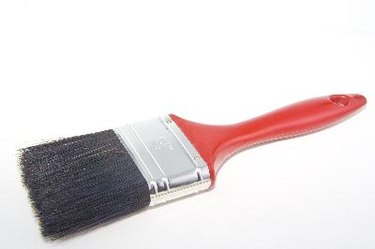Things You'll Need
Polyurethane
Hardener
Paintbrushes
Water or mineral spirits
Paint laquer

Polyurethane paint is admired for its excellent adhesion abilities, gloss, flexibility and tough resistance to poor weather conditions, harsh chemicals and solvents. Oil-based polyurethanes are easier to apply than water-based finishes because they are slower drying and do not raise the wood grain the way water-based finishes can. Learning how to properly apply the paint can be tricky, but the results are well worth the learning process. You can get a great finish with polyurethane if you take the time to do a proper job of it.
Step 1
Check the condition of the hardener before applying it. If the color has turned murky or is milky in appearance instead of clear, there may be a problem with the hardener. Discard and replace it.
Video of the Day
Step 2
Properly prepare your brushes before application. You should use a good-quality, two-inch nylon brush for waterborne polyurethanes and a natural bristle brush for oil-based applications. Soak the brushes in water or mineral spirits for 15 minutes before using them. You should notice air bubbles coming out of the brush as you soak it; wait until this process ceases before using them.
Step 3
Ventilate the room, opening windows so there is a fresh supply of air. Mix the polyurethane and hardener according to the manufacturer's instructions. Thin out the first coat of the mix anywhere from 5 to 25 percent with paint lacquer. This will help minimize bubbling on the surface and will help to better seal the wood.
Step 4
Wring out moisture from the brush before dipping it into the polyurethane. Dip the brush in the polyurethane and lightly run it against the side of the container so it is not dripping wet.
Step 5
Apply the polyurethane over the area in light, thin stokes, being careful not to over-brush. Use slow brush applications and allow the polyurethane to sink into the wood.
Step 6
Wait eight hours before applying a second coat. You may choose to lightly sand with fine-grade sandpaper in between coats if you notice any bubbling, nibs or imperfections. Wipe residual sand dust off with a damp cloth before applying a second coat.
Step 7
Apply a second thin coat of full-strength polyurethane paint. Allow each coat to dry thoroughly before applying any subsequent coats.
Tip
Light sanding between applications of polyurethane will give a smooth, slick appearance to your chosen surface.
Warning
Polyurethane is very toxic to breathe and can cause sickness and death; if applying via spray, you must properly ventilate the room and use a respirator during application.
Video of the Day